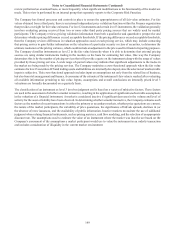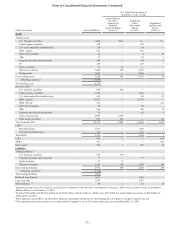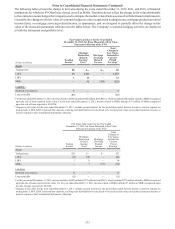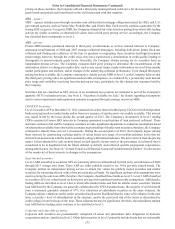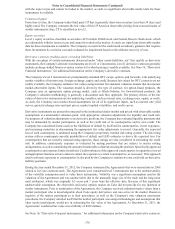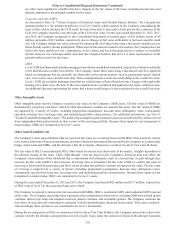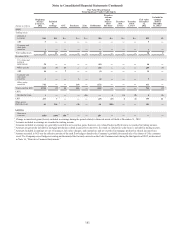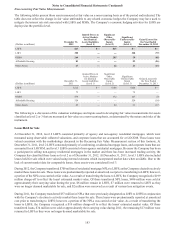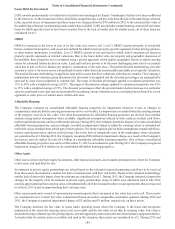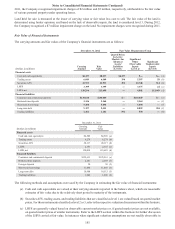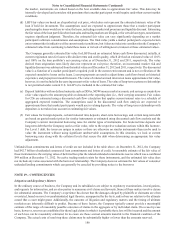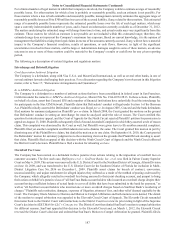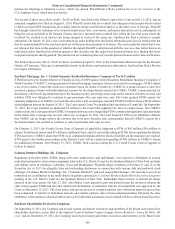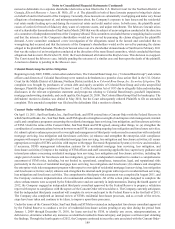SunTrust 2012 Annual Report Download - page 195
Download and view the complete annual report
Please find page 195 of the 2012 SunTrust annual report below. You can navigate through the pages in the report by either clicking on the pages listed below, or by using the keyword search tool below to find specific information within the annual report.Notes to Consolidated Financial Statements (Continued)
179
of litigation involving Visa. The value of the derivative was estimated based on the Company’s expectations regarding the
ultimate resolution of that litigation, which involved a high degree of judgment and subjectivity. Accordingly, the value of
the derivative liability is classified as a level 3 instrument. See Note 17, "Reinsurance Arrangements and Guarantees," for a
discussion of the valuation assumptions.
Contingent consideration associated with acquisitions is adjusted to fair value until settled. As the assumptions used to measure
fair value are based on internal metrics that are not market observable, the earn-out is considered a level 3 liability.
Liabilities
Trading liabilities
Trading liabilities are primarily comprised of derivative contracts, but also include various contracts involving U.S.
Treasury securities, equity securities, and corporate and other debt securities that the Company uses in certain of its
trading businesses. The Company employs the same valuation methodologies for these derivative contracts and
securities as are discussed within the corresponding sections herein under “Trading Assets and Securities Available
for Sale.”
Brokered time deposits
The Company has elected to measure certain CDs at fair value. These debt instruments include embedded derivatives
that are generally based on underlying equity securities or equity indices, but may be based on other underlyings that
may or may not be clearly and closely related to the host debt instrument. The Company elected to carry these
instruments at fair value to remove the mixed attribute accounting model for the single debt instrument or to better
align the economics of the CDs with the Company’s risk management strategies. The Company evaluated, on an
instrument by instrument basis, whether a new issuance would be carried at fair value.
The Company classified these CDs as level 2 instruments due to the Company’s ability to reasonably measure all
significant inputs based on observable market variables. The Company employs a discounted cash flow approach to
the host debt component of the CD, based on observable market interest rates for the term of the CD and an estimate
of the Bank’ s credit risk. For the embedded derivative features, the Company uses the same valuation methodologies
as if the derivative were a standalone derivative, as discussed herein under “Derivative contracts.”
For brokered time deposits carried at fair value, the Company estimated credit spreads above LIBOR, based on credit
spreads from actual or estimated trading levels of the debt or other relevant market data. The Company recognized
losses of $15 million, gains of $2 million, and losses of $41 million for the years ended December 31, 2012, 2011,
and 2010, respectively, due to changes in its own credit spread on its brokered time deposits carried at fair value.
Long-term debt
The Company has elected to carry at fair value certain fixed rate debt issuances of public debt which are valued by
obtaining quotes from a third party pricing service and utilizing broker quotes to corroborate the reasonableness of
those marks. Additionally, information from market data of recent observable trades and indications from buy side
investors, if available, are taken into consideration as additional support for the value. Due to the availability of this
information, the Company determined that the appropriate classification for the debt is level 2. The election to fair
value the debt was made to align the accounting for the debt with the accounting for the derivatives without having
to account for the debt under hedge accounting, thus avoiding the complex and time consuming fair value hedge
accounting requirements.
The Company’s public debt carried at fair value impacts earnings predominantly through changes in the Company’s
credit spreads as the Company has entered into derivative financial instruments that economically convert the interest
rate on the debt from fixed to floating. The estimated earnings impact from changes in credit spreads above U.S.
Treasury rates were losses of $78 million, gains of $57 million, and losses of $95 million for the years ended December
31, 2012, 2011, and 2010, respectively.
The Company also carries approximately $286 million of issued securities contained in a consolidated CLO at fair
value to recognize the nonrecourse nature of these liabilities to the Company. Specifically, the holders of the liabilities
are only paid interest and principal to the extent of the cash flows from the assets of the vehicle, and the Company
has no current or future obligations to fund any of the CLO vehicle’s liabilities. The Company classified these
securities as level 2, as the primary driver of their fair values are the loans owned by the CLO, which the Company
also elected to carry at fair value, as discussed herein under “Loans Held for Investment and Loans Held for Sale –
Corporate and other LHFS.”


